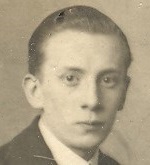Cpl
George Joseph Hocking
Informationen zu Geburt
|
Geburtsdatum: 30/04/1897 |
|
Geburtsort: New Cross, Surrey, England, Vereinigtes Königreich |
Informationen zum Armeedienst
|
Land: England, Vereinigtes Königreich |
|
Truppe: British Expeditionary Force |
|
Rang: Corporal |
|
Dienstnummer: R/23585 |
|
Einberufung ort: Ilford, Essex, England, Vereinigtes Königreich |
|
Einheiten: — King's Royal Rifle Corps, 20th Bn. (British Empire League Pioneers) (Letzte bekannte Einheit) |
Informationen zu Tod
|
Sterbedatum: 12/10/1917 |
|
Sterbeort: Dozinghem Casualty Clearing Station, Westvleteren, Belgien |
|
Todesursache: Im Kampf gefallen |
|
Alter: 20 |
Begräbnisplatz
|
Dozinghem Military Cemetery Grabstelle: XI Reihe: H Grab: 11 |
Auszeichnungen und Orden 2
|
British War Medal Medaille — 03/05/1920 |
|
Victory Medal Medaille — 03/05/1920 |
Punkte von Interesse 3
| #1 | Geburtsort | ||
| #2 | Einberufung ort | ||
| #3 | Ort des Todes (ungefähr) |
Meine Geschichte
Corporal George Joseph Hocking of the Kings Royal Rifle Corps 20th Battalion (British Empire League Pioneers). This Battalion was the divisional pioneer Battalion of the 3rd Division, which was involved in the Third Battle of Ypres, also known as the Battle of Passchendaele. Pioneer battalions generally served more of a supportive role, fulfilling engineering and construction tasks, as opposed to a front-line role. Nevertheless this was arduous and dangerous work, as pioneers often had to work in broad daylight in full view of the German artillery spotters.
On the 22nd of September the 3rd division marched to Ypres to begin work improving communication lines and laying duck-boards etc. On 26 September the Division was ordered to partake in the general attack to capture Zonnebeke after which, the Pioneer Battalion carried out work on the Ypres-Zonnebeke Road till the end of September. For 5-6 weeks, from the 4th of October the 20th Battalion came under order of Vth Corps. On 10 October they were temporarily attached to the 9th Division and were billeted to in dugouts along the canal bank north of Ypres, position 'C25 central', near Boesinghe Road, arriving at 5pm. Here they were subject most days to what is described as 'persistent bombing raids, both night and day'. The battalion's work while with the 9th Division was all in the same 'accursed' area, just beyond St. Julien, called the 'Triangle'. At 11 a.m. every morning a heavy barrage came down on the line of the Poelcappelle road, St. Julien itself, the whole of the Triangle area and the duck-board tracks, both near St. Julien and near Alberta, suffered heavy treatment. On the 11th of October, “A” Company was put to work extending the Alberta track and managed to put down a further 150yards of track. “B” company extended a track from Mousetrap to beyond Tirpitz Farm, laying 100yards of track; and “C” company was tasked with making a new road between the Triangle and Hubner Farm.
Corporal Hocking died of wounds on the 12th of October 1917, aged 20. He must have been wounded at some point after arriving at the canalbank on the 10th of October or on the following day whilst carrying out the above described works. He was then taken to either the 4th, 47th or 61st Casualty Clearing Station, posted at 'Dozinghem' in Westvleteren to receive immediate treatment. From there, had he survived, he would have been moved on to a hospital in France. Corporal Hocking is buried at Dozinghem Military Cemetery Plot 11, Row H, Grave 11. He was awarded both the Victory Medal and the British War Medal for his service.
On the 22nd of September the 3rd division marched to Ypres to begin work improving communication lines and laying duck-boards etc. On 26 September the Division was ordered to partake in the general attack to capture Zonnebeke after which, the Pioneer Battalion carried out work on the Ypres-Zonnebeke Road till the end of September. For 5-6 weeks, from the 4th of October the 20th Battalion came under order of Vth Corps. On 10 October they were temporarily attached to the 9th Division and were billeted to in dugouts along the canal bank north of Ypres, position 'C25 central', near Boesinghe Road, arriving at 5pm. Here they were subject most days to what is described as 'persistent bombing raids, both night and day'. The battalion's work while with the 9th Division was all in the same 'accursed' area, just beyond St. Julien, called the 'Triangle'. At 11 a.m. every morning a heavy barrage came down on the line of the Poelcappelle road, St. Julien itself, the whole of the Triangle area and the duck-board tracks, both near St. Julien and near Alberta, suffered heavy treatment. On the 11th of October, “A” Company was put to work extending the Alberta track and managed to put down a further 150yards of track. “B” company extended a track from Mousetrap to beyond Tirpitz Farm, laying 100yards of track; and “C” company was tasked with making a new road between the Triangle and Hubner Farm.
Corporal Hocking died of wounds on the 12th of October 1917, aged 20. He must have been wounded at some point after arriving at the canalbank on the 10th of October or on the following day whilst carrying out the above described works. He was then taken to either the 4th, 47th or 61st Casualty Clearing Station, posted at 'Dozinghem' in Westvleteren to receive immediate treatment. From there, had he survived, he would have been moved on to a hospital in France. Corporal Hocking is buried at Dozinghem Military Cemetery Plot 11, Row H, Grave 11. He was awarded both the Victory Medal and the British War Medal for his service.
Quellen 1
|
20 Battalion King's Royal Rifle Corps (Pioneers), (The National Archives, KEW (TNA), WO 95/1405/4). https://discovery.nationalarchives.gov.uk/details/r/C14303 Weitere Quellen |
Weitere Informationen 3
|
Commonwealth War Graves Commission Database https://www.cwgc.org/find-records/find-war-dead/casualty-details/621013 |
|
Namenlijst (In Flanders Fields Museum) https://namenlijst.org/publicsearch/#/person/_id=072a6f7f-54d8-4170-9a54-3b6bbf586789 |
|
Lives of the First World War (Imperial War Museum) https://livesofthefirstworldwar.iwm.org.uk/lifestory/5125396 |
